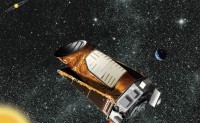Search for Earth-like planets takes a great leap forward

Astronomers from the University of Edinburgh are joining their counterparts in Queen’s University Belfast, Geneva, Harvard, St Andrews and INAF-TNG in the hunt for extra-solar planets similar to the Earth. Together they will build and use a new instrument called HARPS-N for the Italian 3.5-metre Telescopio Nazionale Galileo in the Canary Islands. The instrument will be able to analyse the light of candidates identified from NASA’s Kepler space probe.
Since its launch in March 2009, Kepler has been continually taking images of a single area of sky in the constellation of Cygnus. Of the hundreds of thousands of stars visible in these images, around 1200 show indications of having planetary systems.
Kepler looks for tiny tell-tale dimmings in the light of stars that occur when orbiting planets pass in front of them. However, to be able to understand what kind of worlds these planets are, the light has to be subjected to more detailed examination with the HARPS-N instrument.
HARPS-N will not directly "see" planets. The Kepler planets are far too faint to be seen with any telescope. Instead HARPS looks at their stars and measures the tiny effect the accompanying planets have on their motion. The less massive the planet, the tinier the effect it produces on the star, and the more precise the instrument needed to detect it.
HARPS is able to detect movements at velocities of just a metre per second — the speed of a person walking — in a star hundreds of light-years away. This has allowed planets only a few times more massive than the Earth to be discovered.
The HARPS-N instrument in combination with an analysis of the Kepler data will allow the nature of many of the planets to be understood. Theorists predict that a broad spectrum of different kinds of planet are possible - ranging from solid iron planets through to “solid” water planets - with an Earth-like planet somewhere in between.
“Kepler and HARPS-N offer our first hope of finding planets like the Earth that are at distances from their sun that would allow water to exist as a liquid and - potentially - for life as we know it to evolve,” said Dr Ken Rice of the University's Institute for Astronomy.
HARPS-N project
The HARPS-N project was officially launched in December 2010, with the signing of an international agreement by INAF (Italian National Institute for Astrophysics). HARPS-N will be installed on TNG (Telescopio Nazionale Galileo), the 3.6 meters INAF telescope hosted by the Roque de Los Muchachos observatory, in the Canary Islands.
The HARPS-N project is coordinated by an international consortium led by the Astronomical Observatory of the University of Geneva and comprising: the National Institute for Astrophysics (Italy); the Harvard Smithsonian Astrophysical Observatory, the Harvard College Observatory and the Harvard University Origins of Life Initiative (USA); University of St Andrews; University of Edinburgh, and Queen’s University Belfast (UK).
The project partners are granted 80 observing nights per year to use HARPS-N coupled to the TNG. HARPS-N is currently under construction in Geneva and Edinburgh. Full operating status is scheduled for April 1st, 2012.
The HARPS-N spectrograph (High Accuracy Radial velocity Planet Searcher-North) is being built at Geneva Observatory and the UK Astronomy Technology Centre in Edinburgh. It will operate in the Canary Islands from spring 2012, and will be the northern counterpart of HARPS in the Chilean Andes: currently the most powerful exoplanet hunter in the world.

